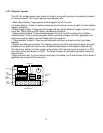
1
CHAPTER 1: INTRODUCTION
1.1 WELCOME TO THE SR-16 DRUM MACHINE!
1.1A If You Just Can't Wait…
Turn to section 1.4, 10 Steps to Instant Gratification, and start making sounds. Some of the
terms in that section may not make sense, but just follow the instructions, and get ready to
hear some great grooves and have a good time. When you're ready to learn more, return to
the beginning to learn SR-16 basics.
The goal of the SR-16's design team has been to create a musical instrument, not a computer
that happens to make sounds. They thank you for your confidence in this product, and hope
that you find the SR-16 a rewarding tool for self-expression that stimulates your creativity (and
tickles your fancy).
1.1B SR-16 Quick Description
The SR-16 includes over 230 high-fidelity drum/percussion sounds, and is easy to operate.
As you tap the 12 drum pads (each of which can be assigned to any of the available sounds),
the SR-16's on-board computer records exactly when you triggered the drum sound and the
dynamics of your playing. You can play back the part, and edit it in various ways.
Data is retained in memory even if the power is turned off. If the memory fills up with drum
Patterns and Songs, this data can be saved permanently to standard cassettes, or to MIDI
System Exclusive storage devices.
The SR-16 also includes a library of preset rhythm Patterns prepared by professional
drummers for those who want to start creating Songs in the fastest and easiest way possible.
1.1C About this Manual
The manual takes you through every function of the SR-16 in the following order:
1. Introduction: Gives the basic ground rules and also covers how to play back drum parts.
2. Record Setup: Tells how to set up the SR-16 to record and edit drum parts.
3. Playing Back and Recording Drum Patterns: Put theory into practice and come up
with some drum parts. Includes material on copying and erasing.
4. Creating and Modifying Drum Sets: The SR-16 includes 50 Preset "drum sets" with
particular choices of sounds, tuning, panning, level, etc. However, you can also create and
modify your own. Each Pattern can have its own associated Drum Set .
5. Song mode: Now that you have a bunch of Patterns, string them together into Songs.
6. MIDI Setup: Here's how to use the SR-16 as part of a MIDI system.
7. Backup: Now that you've come up with some great Songs and rhythm Patterns, it's time
to save them to a cassette recorder or MIDI system exclusive storage device.


















